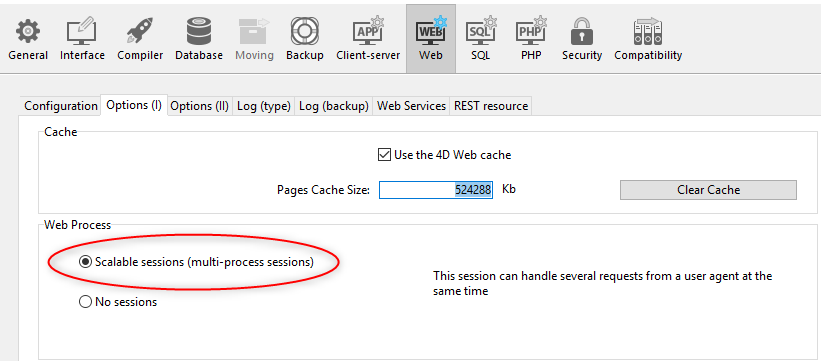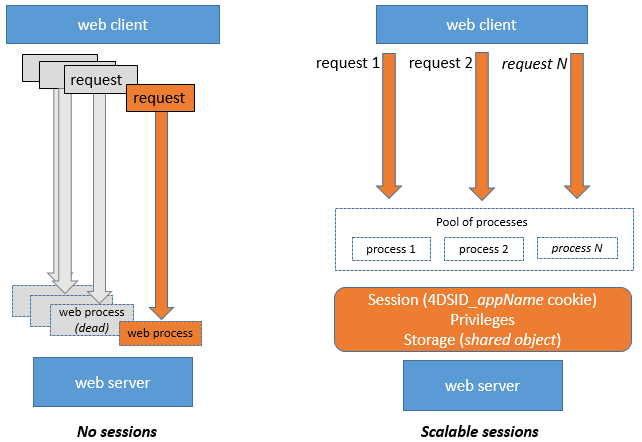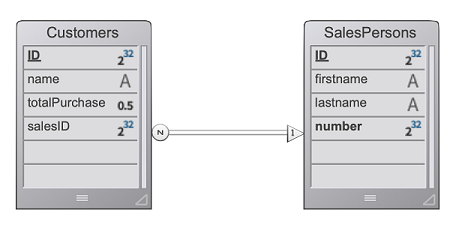Sessões web
O servidor web 4D oferece recursos integrados para gerenciar sessões web. Creating and maintaining web sessions allows you to control and improve the user experience on your web application. When web sessions are enabled, web clients can reuse the same server context from one request to another.
As sessões Web permitem:
- manipular várias solicitações simultaneamente do mesmo cliente web através de um número ilimitado de processos preventivos (sessões web são escaláveis),
- gerenciar a sessão por um objeto
Sessione da API de session, - armazena e compartilha dados entre processos de um cliente web usando o .storage da sessão,
- associate privileges to the user running the session.
Usos
As sessões Web são usadas para:
- Web applications sending http requests (including SOAP Web services and /4DACTION requests),
- calls to the REST API, which are used by remote datastores and Qodly forms.
Enabling web sessions
A funcionalidade de gerenciamento de sessão pode ser ativado e desativado no seu servidor web 4D. Existem diferentes formas de ativar a gestão de sessões:
- Usando a opção Sessões escalonáveis na página "Web/Opções (I)" das Propriedades (configuração permanente):

Esta opção é selecionada por defeito nos novos projetos. Sin embargo, se puede desactivar seleccionando la opción Sin sesiones, en cuyo caso las funcionalidades de la sesión web se desactivan (no hay ningún objeto Session disponible).
- Using the
.scalableSessionproperty of the Web Server object (to pass in the settings parameter of the.start()function). Neste caso, este parâmetro substitui a opção definida na caixa de diálogo Propriedades para o objeto Web Server (não é armazenado em disco).
The
WEB SET OPTIONcommand can also set the session mode for the main Web server.
Em qualquer caso, o parâmetro é local para a máquina; para poder diferir no servidor Web 4D Server e os servidores Web de máquinas 4D remotas.
Compatibilidad: una opción Sesiones legacy está disponible en proyectos creados con una versión de 4D anterior a 4D v18 R6 (para más información, consulte el sitio web doc.4d.com).
Session implementation
When sessions are enabled, automatic mechanisms are implemented, based upon a private cookie set by 4D itself: "4DSID__AppName_", where AppName is the name of the application project. Este cookie faz referência à sessão web atual da aplicação.
O nome do cookie pode ser obtido usando a propriedade .sessionCookieName.
-
En cada petición del cliente web, el servidor web comprueba la presencia y el valor de la cookie privada "4DSID__AppName_".
-
Se o cookie tiver um valor, 4D procura pela sessão que criou este cookie entre as sessões existentes; Se esta sessão for encontrada, ela será reutilizada para a chamada.
-
Se a solicitação do cliente não corresponder a uma sessão já aberta:
- se crea una nueva sesión con una cookie privada "4DSID__AppName_" en el servidor web
- se crea un nuevo objeto Guest
Sessiondedicado a la sesión web escalable.
La creación de una sesión web para una petición REST puede requerir que una licencia esté disponible, consulte esta página.
The Session object of the current session can then be accessed through the Session command in the code of any web processes.

Os processos Web geralmente não terminam, eles são reciclados em um pool para aumentar a eficiência. Quando um processo termina de executar uma solicitação, ele é colocado de novo no pool e disponibilizado para a próxima solicitação. Since a web process can be reused by any session, process variables must be cleared by your code at the end of its execution (using CLEAR VARIABLE for example). Esta limpeza é necessária para todas as informações relacionadas ao processo, como uma referência a um arquivo aberto. Esta es la razón por la que se recomienda utilizar el objeto Sesión cuando se quiera guardar información relacionada con la sesión.
Armazenar e compartilhar informações de sessão
Cada objeto Session fornece uma propriedade .storage que é um objeto compartilhado. Essa propriedade permite que você compartilhe informações entre todos os processos manipulados pela sessão.
Duração da sessão
Uma sessão Web escalável é encerrada quando:
- o servidor web está parado,
- o tempo limite do cookie de sessão foi atingido.
O tempo de vida de um cookie inativo é 60 minutos por padrão, o que significa que o servidor irá automaticamente fechar as sessões inativas após 60 minutos.
This timeout can be set using the .idleTimeout property of the Session object (the timeout cannot be less than 60 minutes) or the connectionInfo parameter of the Open datastore command.
Quando uma sessão Web é fechada, se o comando Session for chamado posteriormente:
- el objeto
Sessionno contiene privilegios (es una sesión de invitado) - a propriedade
storageestá vazia - um novo cookie de sessão é associado à sessão
Você pode fechar uma sessão em um formulário Qodly usando o recurso logout.
Privilégios
Os privilégios podem ser associados a sessões usuário Web. No servidor web, você pode fornecer acesso ou recursos específicos, dependendo dos privilégios da sessão.
Você atribui privilégios usando a função .setPrivileges(). Em seu código, você pode verificar os privilégios da sessão para permitir ou negar o acesso usando a função .hasPrivilege(). Por padrão, as novas sessões não têm nenhum privilégio: elas são sessões Guest (.isGuest() retorna true).
Exemplo:
If (Session.hasPrivilege("WebAdmin"))
//Access is granted, do nothing
Else
//Display an authentication page
End if
Privileges are implemented at the heart of the ORDA architecture to provide developers with a powerful technology for controlling access to the datastore and dataclas functions. Para mais informações, consulte a página Privilégios do capítulo ORDA.
Exemplo
Em uma aplicação CRM, cada vendedor gerencia seu próprio portefólio de clientes. A datastore contém pelo menos dois dataclasses ligados: Customers e SalesPersons (um vendedor tem vários clientes).

Queremos que um vendedor autentique, abra uma sessão no servidor web e que os 3 primeiros clientes sejam carregados na sessão.
- Executamos este URL para abrir uma sessão:
http://localhost:8044/authenticate.shtml
En un entorno de producción, es necesario utilizar una conexión HTTPS para evitar que cualquier información no cifrada circule por la red.
- La página
authenticate.shtmles un formulario que contiene los campos de entrada userId y password y envía una acción 4DACTION POST:
<!DOCTYPE html>
<html>
<body bgcolor="#ffffff">
<FORM ACTION="/4DACTION/authenticate" METHOD=POST>
UserId: <INPUT TYPE=TEXT NAME=userId VALUE=""><br/>
Password: <INPUT TYPE=TEXT NAME=password VALUE=""><br/>
<INPUT TYPE=SUBMIT NAME=OK VALUE="Log In">
</FORM>
</body>
</html>
- El método authenticate project busca la persona userID y valida la contraseña contra el valor hash ya almacenado en la tabla SalesPersons:
var $indexUserId; $indexPassword; $userId : Integer
var $password : Text
var $userTop3; $sales; $info : Object
ARRAY TEXT($anames; 0)
ARRAY TEXT($avalues; 0)
WEB GET VARIABLES($anames; $avalues)
$indexUserId:=Find in array($anames; "userId")
$userId:=Num($avalues{$indexUserId})
$indexPassword:=Find in array($anames; "password")
$password:=$avalues{$indexPassword}
$sales:=ds.SalesPersons.query("userId = :1"; $userId).first()
If ($sales#Null)
If (Verify password hash($password; $sales.password))
$info:=New object()
$info.userName:=$sales.firstname+" "+$sales.lastname
Session.setPrivileges($info)
Use (Session.storage)
If (Session.storage.myTop3=Null)
$userTop3:=$sales.customers.orderBy("totalPurchase desc").slice(0; 3)
Session.storage.myTop3:=$userTop3
End if
End use
WEB SEND HTTP REDIRECT("/authenticationOK.shtml")
Else
WEB SEND TEXT("This password is wrong")
End if
Else
WEB SEND TEXT("This userId is unknown")
End if
Token de sessão (OTP)
The 4D web server allows you to generate, share, and use OTP (One-Time Passcode) session tokens. OTP session tokens are used to secure communications with third-party applications or websites. For information on OTP, please refer to the One-time password page on Wikipedia.
In 4D, OTP session tokens are useful when calling external URLs and being called back in another browser or device (mobile/computer). Typically, a third-party application sends a confirmation email containing a callback link on which the user has to click. The callback link includes the OTP token, so that the session which triggered the callback is loaded along with its data and privileges. This principle allows you to share the same session on multiple devices. Graças a esta arquitetura, o cookie de sessão não está exposto na rede, o que elimina o risco de ataque do homem-meio.
Visão Geral
The basic sequence of an OTP session token use in a 4D web application is the following:
- The web user initiates an action that requires a secured third-party connection, for example a validation, from within a specific session.
- No seu código 4D, você cria um OTP para a sessão usando a função
Session.createOTP(). - You send a request to the third-party application with the session token included in the callback Uri. Note that the way to provide the callback Uri to a third-party application depends on its API (see below).
- The third-party application sends back a request to 4D with the pattern you provided in the callback Uri.
- The request callback is processed in your application.
By definition, an OTP token can only be used once. In this scenario, if a web request is received with a session token as parameter that has already been used, the initial session is not restored.
Processing the OTP in the callback
Callbacks from third-party applications that include the OTP token can be processed in different ways in your 4D application, depending on your development and the third-party API. Basically, you have two possibilities to handle the token: through the $4DSID parameter for an automatic processing, or through a custom parameter that you need to process.
Usando $4DSID no URL
Using the $4DSID parameter is the most simple way to process a callback from the third-party application:
- The OTP token is provided as a parameter directly in the callback url using the standard
?$4DSID=XXXX123syntax. - In 4D, you implement a dedicated HTTP Request handler in your 4D application using
IncomingMessageandOutgoingMessageclasses. - If the
$4DSIDtoken is valid, the related web user session is automatically restored in any web process with its storage and privileges.
Um url 4DACTION também pode ser usada no lado 4D.
Usando um parâmetro personalizado
The OTP token can also be provided as a custom parameter that you need to process specifically to restore the session. You must use this solution if:
- the third-party application does not allow to insert parameters such as a
$4DSIDdirectly in the redirect Uri, and provides a dedicated API (the implementation depends on the third-party application), - ou, você deseja chamar uma função ORDA através do REST para processar a callback, nesse caso você precisa passar o OTP com a sintaxe do parâmetro REST (por exemplo,
?$params='["XXX123"]').
Em ambos os casos, você precisa extrair o token do parâmetro personalizado e chamar a Session.restore() com o token como parâmetro.
Processando um OTP inválido
The OTP token is considered invalid if:
- o token de sessão já foi usado,
- o token de sessão expirou,
- o token de sessão não existe,
- a própria sessão original expirou.
In this case, no web user session is restored and the current session (if any) is left unchanged. Usually, you can decide to display a login page or to open a guest session.
Verifying if the received OTP token is valid depends on how it was handled:
- If you used a
$4DSID, you can store a custom status property in the session storage at the moment of the token creation, and check this status once the OTP token was received to see if it is the same value (see example). - Se você usou a função
Session.restore(), ele retorna verdadeiro se a sessão foi restaurada corretamente.
Cenário com $4DSID
O cenário usando a chave $4DSID é ilustrado no seguinte diagrama:
The 4D HTTP request handler definition:
[
{
"class": "OperationsHandler",
"method": "handleOperation",
"regexPattern": "/my4DApp/completeOperation",
"verbs": "get"
}
]
A classe singleton:
//Class OperationsHandler
shared singleton Class constructor()
function handleOperation($request : 4D.IncomingMessage)
$session:=Session
Cenário com a função 'restore'
The scenario using a custom parameter is illustrated in the following diagram:
The 4D HTTP request handler definition:
[
{
"class": "OperationsHandler",
"method": "handleOperation",
"regexPattern": "/my4DApp/completeOperation",
"verbs": "get"
}
]
A classe singleton:
//Class OperationsHandler
shared singleton Class constructor()
Function handleOperation($req : 4D.IncomingMessage) : 4D.OutgoingMessage
Session.restore($req.urlQuery.state)
Exemplo de validação de e-mail com $4DSID
- A user account is created in a Users dataclass. A $info object is received with the email and password. An OTP corresponding to the current session is generated. An URL is then returned with this OTP given in the $4DSID parameter.
//cs.Users class
Function create($info : Object) : Text
var $user : cs.UsersEntity
var $status : Object
var $token : Text
$user:=This.new() //create a new user
$user.fromObject($info)
$status:=$user.save()
//Store information in the session
//including user creation status
Use (Session.storage)
Session.storage.status:=New shared object("step"; "Waiting for validation email"; /
"email"; $user.email; "ID"; $user.ID)
End use
//Generate an OTP corresponding to the session
$token:=Session.createOTP()
// Return an URL with a $4DSID parameter
return "https://my.server.com/tools/validateEmail?$4DSID="+$token`
- The user is sent this URL as a link in an email. O prefixo URL
/validateEmailé tratado por um manipulador de requisição HTTP personalizado:
[
{
"class": "RequestHandler",
"method": "validateEmail",
"regexPattern": "/validateEmail",
"verbs": "get"
}
]
The validateEmail() function of the RequestHandler singleton:
//validateEmail class
shared singleton Class constructor()
Function validateEmail() : 4D.OutgoingMessage
var $result:=4D.OutgoingMessage.new()
//The session which generated the OTP is retrieved
//thanks to the $4DSID parameter given in the URL
If (Session.storage.status.step="Waiting for validation email")
$user:=ds.Users.get(Session.storage.status.ID)
$user.emailValidated() //set to true
$result.setBody("Congratulations <br>"\
+"Your email "+Session.storage.status.email+" has been validated")
$result.setHeader("Content-Type"; "text/html"
Use (Session.storage.status)
Session.storage.status.step:="Email validated"
End use
Else
$result.setBody("Invalid token")
End if
return $result
Since the $4DSID parameter contains a valid OTP corresponding to the original session, the Session object refers to the session that created the OTP.
A new user is created, and some information is stored in the session, especially the current step of the user account creation process (Waiting for validation email) and the user ID.
Contextos suportados
- Both HTTP and HTTPS schemas are supported.
- Apenas sessões escaláveis podem ser reutilizadas com tokens.
- Somente as sessões do banco de dados do host podem ser reutilizadas (as sessões criadas em servidores Web de componentes não podem ser restauradas).
- Tokens are not supported with client/server sessions or single-user sessions.
Lifespan
A session token has a lifespan, and the session itself has a lifespan. O tempo de vida útil do token de sessão pode ser definido na criação do token. Por padrão, o tempo de vida do token é o mesmo valor que o valor .idleTimeout.
A session is only restored by a token if both the session token lifespan and the session lifespan have not expired. In other cases (the session token has expired and/or the session itself has expired), a guest session is created when a web request with a session token is received.